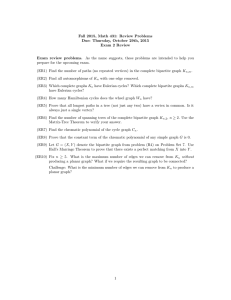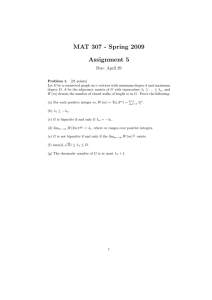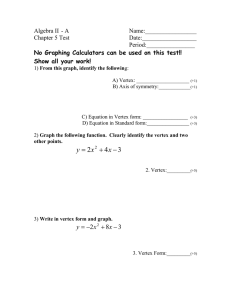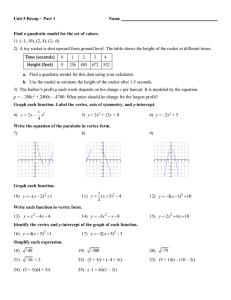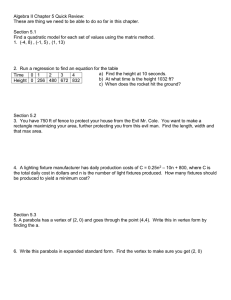Unmixed bipartite graphs and sublattices of the Boolean lattices Jürgen Herzog
advertisement
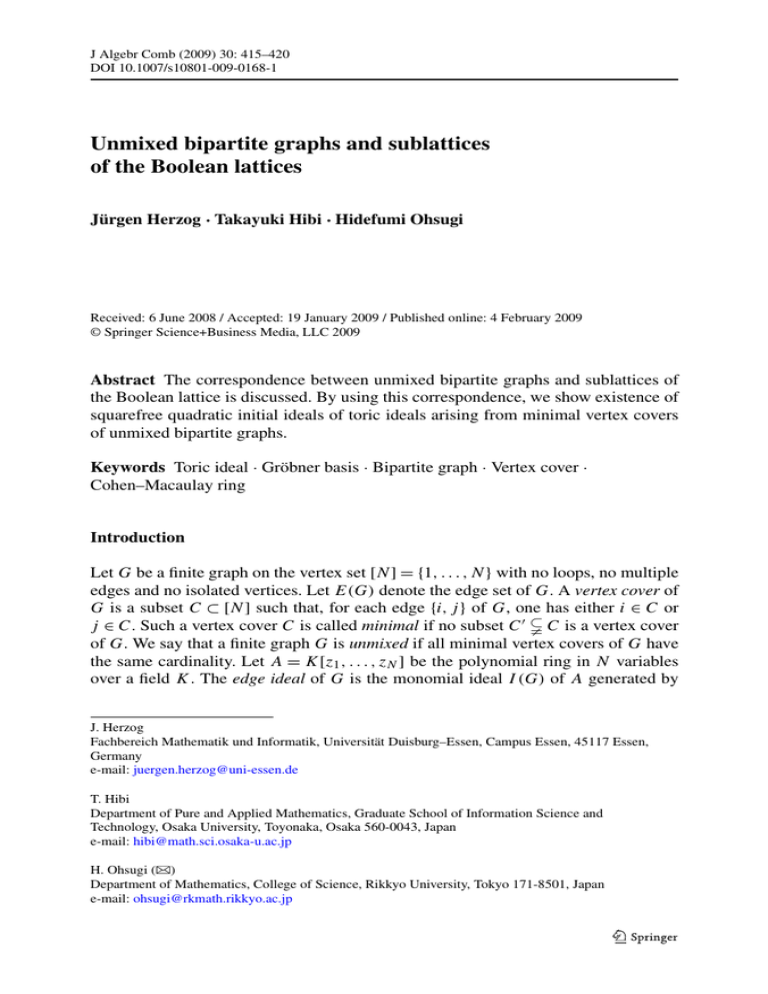
J Algebr Comb (2009) 30: 415–420
DOI 10.1007/s10801-009-0168-1
Unmixed bipartite graphs and sublattices
of the Boolean lattices
Jürgen Herzog · Takayuki Hibi · Hidefumi Ohsugi
Received: 6 June 2008 / Accepted: 19 January 2009 / Published online: 4 February 2009
© Springer Science+Business Media, LLC 2009
Abstract The correspondence between unmixed bipartite graphs and sublattices of
the Boolean lattice is discussed. By using this correspondence, we show existence of
squarefree quadratic initial ideals of toric ideals arising from minimal vertex covers
of unmixed bipartite graphs.
Keywords Toric ideal · Gröbner basis · Bipartite graph · Vertex cover ·
Cohen–Macaulay ring
Introduction
Let G be a finite graph on the vertex set [N] = {1, . . . , N} with no loops, no multiple
edges and no isolated vertices. Let E(G) denote the edge set of G. A vertex cover of
G is a subset C ⊂ [N ] such that, for each edge {i, j } of G, one has either i ∈ C or
j ∈ C. Such a vertex cover C is called minimal if no subset C C is a vertex cover
of G. We say that a finite graph G is unmixed if all minimal vertex covers of G have
the same cardinality. Let A = K[z1 , . . . , zN ] be the polynomial ring in N variables
over a field K. The edge ideal of G is the monomial ideal I (G) of A generated by
J. Herzog
Fachbereich Mathematik und Informatik, Universität Duisburg–Essen, Campus Essen, 45117 Essen,
Germany
e-mail: juergen.herzog@uni-essen.de
T. Hibi
Department of Pure and Applied Mathematics, Graduate School of Information Science and
Technology, Osaka University, Toyonaka, Osaka 560-0043, Japan
e-mail: hibi@math.sci.osaka-u.ac.jp
H. Ohsugi ()
Department of Mathematics, College of Science, Rikkyo University, Tokyo 171-8501, Japan
e-mail: ohsugi@rkmath.rikkyo.ac.jp
416
J Algebr Comb (2009) 30: 415–420
those quadratic monomials zi zj such that {i, j } is an edge of G. It is well-known that
the primary decomposition of the edge ideal of G is
I (G) =
zi | i ∈ C
C∈M(G)
where M(G) is the set of all minimal vertex covers of G. We say that G is
Cohen–Macaulay (over K) if the quotient ring A/I (G) is Cohen–Macaulay. Every
Cohen–Macaulay graph is unmixed. A graph-theoretical characterization of Cohen–
Macaulay bipartite graphs was given in [1] and that of unmixed bipartite graphs was
given in [5].
By relabeling the vertices, every unmixed bipartite graph G has the vertex set
{x1 , . . . , xn } ∪ {y1 , . . . , yn } and satisfies that {xi , yi } ∈ E(G) for all i (See Section 1).
In Sections 1 and 2, we study the correspondence between unmixed bipartite graphs
and sublattices of the Boolean lattice Ln on {x1 , . . . , xn }:
• There exists a one-to-one correspondence between unmixed bipartite graphs on
{x1 , . . . , xn } ∪ {y1 , . . . , yn } where {xi , yi } ∈ E(G) for all i and sublattices L of Ln
with ∅ ∈ L and {x1 , . . . , xn } ∈ L. (Theorem 1.2.)
• There exists a one-to-one correspondence between Cohen–Macaulay bipartite
graphs on {x1 , . . . , xn } ∪ {y1 , . . . , yn } where {xi , yi } ∈ E(G) for all i and full sublattices of Ln . (Theorem 2.2.)
In Section 3, we study toric ideals arising from the set of minimal vertex covers of unmixed bipartite graphs. Let G be an unmixed bipartite graph on the vertex
set {x1 , . . . , xn } ∪ {y1 , . . . , yn } and let K[x1 , . . . , xn , y1 , . . . , yn ] be the polynomial
ring in 2n variables over a field K with each deg xi = deg yi = 1. We associate
each minimal vertex cover C of G with the squarefree monomial uC = v∈C v ∈
K[x1 , . . . , xn , y1 , . . . , yn ] of degree n. Let RG denote the semigroup ring generated
by all monomials uC with C ∈ M(G) over K. Let SG = K[{zC }C∈M(G) ] denote the
polynomial ring in |M(G)| variables over K. The toric ideal IG of RG is the kernel
of the surjective homomorphism π : SG → RG defined by π(zC ) = uC . In Section 3,
by using the correspondence given in Section 1, we show that:
• The toric ideal arising from an unmixed bipartite graph possesses a squarefree
quadratic initial ideal. (Theorem 3.1.)
1 Minimal vertex covers of unmixed bipartite graphs
First we recall a fact stated in [1, p.300]. Let G be a bipartite graph without isolated
vertices and let V (G) = {x1 , . . . , xm } ∪ {y1 , . . . , yn } denote the set of vertices of G.
Suppose that G is unmixed. Since {x1 , . . . , xm } and {y1 , . . . , yn } are minimal vertex
covers of G, we have m = n. Moreover, thanks to the “marriage theorem,” {xi , yi } ∈
E(G) for all i by relabeling the vertices.
Thanks to this fact, it follows that each minimal vertex cover of G is of the
form {xi1 , . . . , xis , yis+1 , . . . , yin } where {i1 , . . . , in } = [n]. For a minimal vertex cover
J Algebr Comb (2009) 30: 415–420
417
C = {xi1 , . . . , xis , yis+1 , . . . , yin } of G, we set C = {xi1 , . . . , xis }. Let Ln denote the
Boolean lattice on the set {x1 , . . . , xn } and let
LG = {C | C is a minimal vertex cover of G} (⊂ Ln ).
Remark 1.1 Let G and G be unmixed bipartite graphs on {x1 , . . . , xn }∪{y1 , . . . , yn }.
(i) Both ∅ and {x1 , . . . , xn } belong to LG .
(ii) If G = G , then we have I (G) = I (G ). Hence LG = LG follows from the primary decomposition of the edge ideals.
Theorem 1.2 Let L be a subset of Ln . Then there exists a (unique) unmixed bipartite graph G on {x1 , . . . , xn } ∪ {y1 , . . . , yn } such that L = LG if and only if ∅ and
{x1 , . . . , xn } belong to L and L is a sublattice of Ln .
Proof (“Only if”) Suppose that both C = {xi1 , . . . , xis , yis+1 , . . . , yin } and C =
{xj1 , . . . , xjt , yjt+1 , . . . , yjn } are minimal vertex covers of G. Then
{yk | xk ∈
/ C ∩ C } = {yis+1 , . . . , yin } ∪ {yjt+1 , . . . , yjn },
{yk | xk ∈
/ C ∪ C } = {yis+1 , . . . , yin } ∩ {yjt+1 , . . . , yjn }.
First we show that C ∩ C ∈ LG , that is, C1 = (C ∩ C ) ∪ {yk | xk ∈
/ C ∩ C } is a
/ {yk | xk ∈
/
minimal vertex cover of G. Suppose that an edge {xi , yj } of G satisfies yj ∈
C ∩ C } = {yis+1 , . . . , yin } ∪ {yjt+1 , . . . , yjn }. Since C (resp. C ) is a vertex cover of
G, we have xi ∈ C (resp. xi ∈ C ). Hence xi ∈ C ∩ C . Thus C1 is a minimal vertex
cover of G.
/ C ∪ C } is a
Second we show that C ∪ C ∈ LG , that is, C2 = (C ∪ C ) ∪ {yk | xk ∈
/ C ∪ C.
minimal vertex cover of G. Suppose that an edge {xi , yj } of G satisfies xi ∈
Since C (resp. C ) is a vertex cover of G, we have yj ∈ {yis+1 , . . . , yin } (resp. yj ∈
/ C ∪ C}
{yjt+1 , . . . , yjn }). Thus yj ∈ {yis+1 , . . . , yin } ∩ {yjt+1 , . . . , yjn } = {yk | xk ∈
and hence C2 is a minimal vertex cover of G.
∗
/ S}. Let I be an
(“If”)
For each∗element S ∈ L, let S denote the set {yj | xj ∈
ideal S∈L S ∪ S . We will show that there exists an unmixed bipartite graph G
such that I = xi yj | {xi , yj } ∈ E(G) . Since ∅ ∈ L and {x1 , . . . , xn } ∈ L, I ⊂ xi yj | 1 ≤ i, j ≤ n . Suppose that a monomial M of degree ≥ 3 belongs to the minimal set of generators of I .
Suppose that M = xi xj u where i = j and u is a (squarefree) monomial. Since
/ I , there exists S ∈ L such that
/ S ∪ S ∗ . Moreover since xi u ∈
/ I,
xj u ∈
xj u ∗∈
and
.
Then
we
have
x
that
x
u
∈
/
S
∪
S
,
x
∈
/
S
∩
S
there exists S ∈ L such
i
i
j
u∈
/ S ∪ S ∪ S ∗ ∪ S ∗ . Since L is a sublattice of Ln , S ∩S ∈ L. Note that (S ∩S )∗ =
S ∗ ∪ S ∗ . Hence we have I ⊂ (S ∩ S ) ∪ (S ∗ ∪ S ∗ ) . However, none of the variables
in xi xj u appear in the set (S ∩ S ) ∪ (S ∗ ∪ S ∗ ) contradicting the fact that xi xj u ∈ I .
Suppose that M = yi yj u where i = j and u is a (squarefree) monomial. Since
/ I , there exists S ∈ L such
yju ∈
/ S ∪ S ∗ . Moreover since yi u ∈
/ I , there
yj u ∈
that
∗
∗ ∩ S ∗ and u ∈
.
Then
we
have
y
∈
L
such
that
y
u
∈
/
S
∪
S
,
y
∈
/
S
/
exists
S
i
i
j
S ∪ S ∪ S ∗ ∪ S ∗ . Since L is a sublattice of Ln , S ∪ S ∈ L. Note that (S ∪ S )∗ =
418
J Algebr Comb (2009) 30: 415–420
S ∗ ∩ S ∗ . Hence we have I ⊂ (S ∪ S ) ∪ (S ∗ ∩ S ∗ ) . However, none of the variables
in yi yj u appear in the set (S ∪ S ) ∪ (S ∗ ∩ S ∗ ) contradicting the fact that yi yj u ∈ I .
Thus the minimal set of generators of I is a subset of {xi yj | 1 ≤ i, j ≤ n}. Moreover, since either xi or yi belongs to S ∪ S ∗ for all S ∈ L, xi yi ∈ I for all i. Hence
there exists a bipartite graph G such that I = I (G) and {x
i , yi } ∈ E(G). Since the
primary decomposition of the edge ideal I (G) of G is I = C∈M(G) C, it follows
that M(G) = {S ∪ S ∗ | S ∈ L}. Thus we have L = LG . Since the cardinality of each
S ∪ S ∗ with S ∈ L is n, G is unmixed as desired.
2 Minimal vertex covers of Cohen–Macaulay bipartite graphs
As before, let G be a finite graph on [N ] and A = K[z1 , . . . , zN ] the polynomial ring
in N variables over a field K. The edge ideal of G is the monomial ideal I (G) of A
generated by those quadratic monomials zi zj such that {i, j } is an edge of G. We say
that G is Cohen–Macaulay (over K) if the quotient ring A/I (G) is Cohen–Macaulay.
Every Cohen–Macaulay graph is unmixed.
Given a finite poset (partially ordered set) P = {p1 , . . . , pn }, we introduce the
bipartite graph GP on the vertex set {x1 , . . . , xn } ∪ {y1 , . . . , yn } whose edges are
those 2-element subsets {xi , yj } with pi ≤ pj . In particular for each i ∈ [n] the edge
{xi , yi } belongs to GP . It is known [1] that GP is Cohen–Macaulay. Conversely,
given a Cohen–Macaulay bipartite graph G, there is a finite poset P with G = GP .
A subset α ⊂ P is called a poset ideal of P if α enjoys the property that if pi ∈ α
and pj ≤ pi , then pj ∈ α. In particular the empty set and P itself are poset ideals of
P . For each poset ideal α of P , we set αx = {xi | pi ∈ α} and αy = {yj | pj ∈ α}.
Lemma 2.1 The set αx ∪ αy is a minimal vertex cover of GP . Conversely, every
minimal vertex cover of GP is of the form βx ∪ βy for some poset ideal β of P .
Proof Let α be a poset ideal of P . We show that C = αx ∪ αy is a minimal vertex
cover of GP . Let {xi , yj } be an edge of G. Then pi ≤ pj . Suppose xi ∈ αx . Then
pi ∈ α. Since α is a poset ideal of P , it follows that pj ∈ α. Thus yj ∈ αy . Hence
C is a vertex cover of G. Since GP is unmixed and |C| = n, it follows that C is a
minimal vertex cover.
Conversely, given a minimal vertex cover C = {xi1 , . . . , xis } ∪ {yis+1 , . . . , yin } of
GP , where {i1 , . . . , in } = [n], we prove that α = {pi1 , . . . , pis } is a poset ideal of P .
Let pij ∈ α and pa < pij in P . Then {xa , yij } is an edge of GP . Suppose pa ∈ α.
Then xa ∈ C. Since xij ∈ C, one has yij ∈ C. Thus neither xa nor yij belongs to C.
However, {xa , yij } is an edge of GP . Thus C cannot be a vertex cover of GP . Hence
pa ∈ α. Consequently, α is a poset ideal of GP , as desired.
As before, let Ln denote the Boolean lattice on {x1 , . . . , xn }. A sublattice L of
Ln is called full if the rank of L is equal to n. Here the rank of L is defined to be
the nonnegative integer − 1, where is the maximal cardinality of chains (totally
ordered subsets) of L.
Let P be a finite poset with |P | = n and J (P ) the set of all poset ideals of P .
It turns out that the subset J (P ) of Ln is a full sublattice of Ln . Conversely, the
J Algebr Comb (2009) 30: 415–420
419
classical fundamental structure theorem for finite distributive lattices [3, pp. 118–
119] guarantees that every full sublattice of Ln is of the form J (P ) for a unique
poset P with |P | = n.
Theorem 2.2 A subset L of Ln is a full sublattice of Ln if and only if there exists a
Cohen–Macaulay bipartite graph G on {x1 , . . . , xn } ∪ {y1 , . . . , yn } with L = LG .
Proof (“If”) Let G be a Cohen–Macaulay bipartite graph on the set {x1 , . . . , xn } ∪
{y1 , . . . , yn } and P a poset with G = GP , where |P | = n. Lemma 2.1 says that LG
coincides with J (P ). Thus LG is a full sublattice of Ln .
(“Only if”) Suppose that L is a full sublattice of Ln . One has L = J (P ) for a
unique poset P with |P | = n. Let G = GP . Then G is a Cohen–Macaulay bipartite
graph. Lemma 2.1 says that LG coincides with J (P ). Thus LG = L, as required. 3 Toric ideals arising from minimal vertex covers
Let G be an unmixed bipartite graph on the vertex set {x1 , . . . , xn } ∪ {y1 , . . . , yn }
and let K[x1 , . . . , xn , y1 , . . . , yn ] be the polynomial ring in 2n variables over a field
K with each deg xi = deg yi = 1. Let M(G) denote the set of all minimal vertex
covers of G. Weassociate each minimal vertex cover C of G with the squarefree
monomial uC = v∈C v ∈ K[x1 , . . . , xn , y1 , . . . , yn ] of degree n. Let RG denote the
semigroup ring generated by all monomials uC with C ∈ M(G) over K. Let SG =
K[{zC }C∈M(G) ] denote the polynomial ring in |M(G)| variables over K. The toric
ideal IG of RG is the kernel of the surjective homomorphism π : SG → RG defined
by π(zC ) = uC .
Theorem 3.1 Let G be an unmixed bipartite graph. Then the toric ideal IG of RG
has a squarefree quadratic initial ideal with respect to a reverse lexicographic order.
Proof Let G0 denote the (unmixed) bipartite graph with the edge set E(G) =
{{x1 , y1 }, . . . , {xn , yn }}. Then LG0 is the Boolean lattice on {x1 , . . . , xn }. It is known
[2] that the reduced Gröbner basis of toric ideal of RG0 with respect to a suitable
reverse lexicographic order is
G0 = { zC zC − zC∩C zC∪C | C, C ∈ M(G), C = C }
where the initial monomial of each binomial of G0 is the first monomial.
Let G be an unmixed bipartite graph on the vertex set {x1 , . . . , xn } ∪ {y1 , . . . , yn }.
Then LG is a sublattice of LG0 . Hence we have the following:
(i) IG = IG0 ∩ SG (by [4, Proposition 4.13 (a)]);
(ii) If C and C belong to M(G), then C ∩ C and C ∪ C belong to M(G). Thus,
if zC zC ∈ SG , then we have zC∩C zC∪C ∈ SG .
Thanks to the elimination property above, G0 ∩ SG is a Gröbner basis of the toric
ideal IG of RG as desired.
420
J Algebr Comb (2009) 30: 415–420
Corollary 3.2 Let G be an unmixed bipartite graph. Then the semigroup ring RG is
normal and Koszul.
References
1. Herzog, J., Hibi, T.: Distributive lattices, bipartite graphs and Alexander duality. J. Algebr. Comb. 22,
289–302 (2005)
2. Hibi, T.: Distributive lattices, affine semigroup rings and algebras with straightening laws. In: Nagata,
M., Matsumura, H. (eds.) Commutative Algebra and Combinatorics. Advanced Studies in Pure Math.,
vol. 11, pp. 93–109. North–Holland, Amsterdam (1987)
3. Hibi, T.: Algebraic Combinatorics of Convex Polytopes. Carslaw, Glebe (1992)
4. Sturmfels, B.: Gröbner Bases and Convex Polytopes. Amer. Math. Soc., Providence (1995)
5. Villarreal, R.H.: Unmixed bipartite graphs. Rev. Colomb. Mat. 41(2), 393–395 (2007)
